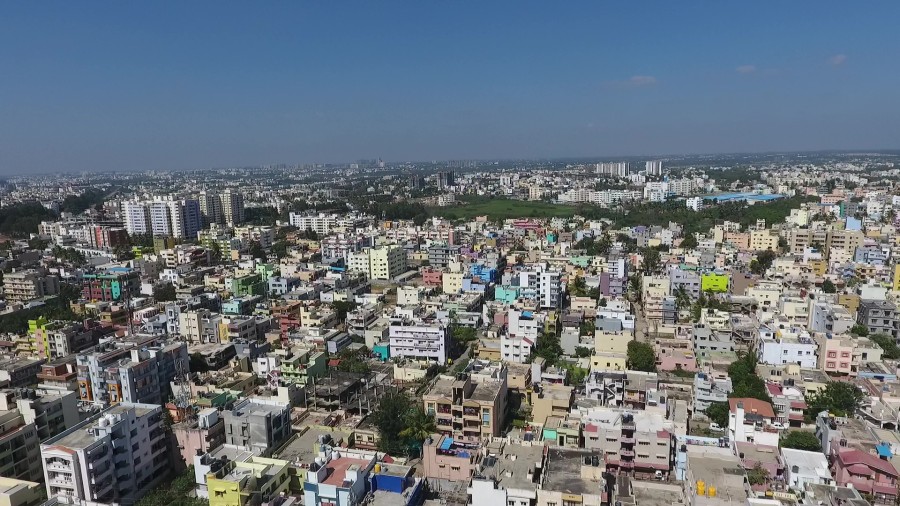
- Home
- News
- Analysis
- States
- Perspective
- Videos
- Education
- Entertainment
- Elections
- World Cup 2023
- Features
- Health
- Business
- Series
- Economy Series
- Earth Day
- Kashmir’s Frozen Turbulence
- India@75
- The legend of Ramjanmabhoomi
- Liberalisation@30
- How to tame a dragon
- Celebrating biodiversity
- Farm Matters
- 50 days of solitude
- Bringing Migrants Home
- Budget 2020
- Jharkhand Votes
- The Federal Investigates
- The Federal Impact
- Vanishing Sand
- Gandhi @ 150
- Andhra Today
- Field report
- Operation Gulmarg
- Pandemic @1 Mn in India
- The Federal Year-End
- The Zero Year
- Premium
- Science
- Brand studio
- Home
- NewsNews
- Analysis
- StatesStates
- PerspectivePerspective
- VideosVideos
- Entertainment
- ElectionsElections
- Sports
- Loading...
Sports - Features
- BusinessBusiness
- Premium
- Loading...
Premium

When Bengaluru, the Garden City, fell prey to mindless development

Bengaluru, one of the first cities in India to have an urban development plan, has grown into an unwieldy, badly planned mess. Once the ‘garden city’ and ‘pensioner’s paradise’, it has acquired labels like ‘garbage city’ and is the butt of all jokes on traffic jams. What happened to Bengaluru’s urban development plans? The city notified a green belt in the late 1970s that...
Bengaluru, one of the first cities in India to have an urban development plan, has grown into an unwieldy, badly planned mess. Once the ‘garden city’ and ‘pensioner’s paradise’, it has acquired labels like ‘garbage city’ and is the butt of all jokes on traffic jams. What happened to Bengaluru’s urban development plans?
The city notified a green belt in the late 1970s that would act as a boundary for urban growth and preserve its lung space. At the time, 500 sq km was designated as metropolitan area, 220 sq km as conurbation area and 280 sq km as agricultural zone. In 1984, the metropolitan planning area was increased to 1,279 sq km, the conurbation area to 439 sq km and agricultural zone to 840 sq km.
In 2007, to accommodate the city’s growing population, another expansion was undertaken. Seven adjoining city municipal corporations, one town municipal corporation, and about 110 villages were merged with the erstwhile Bengaluru metropolitan area to make space for the steady influx of people.

Rapid urbanisation
Bengaluru has emerged as one of the fastest growing cities in India. Rapid urbanisation, rise in population and increase in inflow of migrants led by the city’s IT boom caused an unplanned urban sprawl. Peri-urbanisation adversely affected the fringe areas. It led to a crisis situation on various fronts — water management, choking traffic as a result of the increase in number of vehicles, and a rise in pollution because of dwindling green spaces.
According to an Indian Institute of Science (IISc) report, urbanisation between 1973 and 2016 in Bengaluru resulted in an 88 per cent decline in vegetation, and 79 per cent decline in wetlands, besides an increase in air pollutants and decrease in the groundwater table.
In an attempt to deal with the city’s water crisis, Karnataka Deputy Chief Minister G Parameshwara stoked a controversy last week by saying that the Congress-JD(S) coalition government planned a five-year ban on the construction of residential high-rises in the capital city.
The decision evoked a mixed response. While some thought, though the decision came late, the move was in the right direction, many felt it was a knee-jerk reaction by a government that hadn’t given enough thought to the severity of the situation.
Retired IAS officer V Balasubramanian, who served as the chief secretary to the late chief minister Ramakrishna Hegde in the 1980s, says while Parameshwara’s suggestion might not address the immediate concern, it would help contain the larger problem to some extent. “The city has about 4 lakh borewells and draws water 3.7 times the recharge capacity from rain water. Addressing water issues should be the priority rather than targeting land use, something successive governments have failed to do,” Balasubramanian says.
He cites instances of cities that were abandoned due to scarcity of water, like Uttar Pradesh’s Fatehpur Sikri, a city built by Akbar near Agra, and Karnataka’s Bijapur, the capital of Adil Shahi’s kingdom. “Bijapur had a population of 9,30,000 at one point in time. After the lakes dried up, there are only about 3.2 lakh people left who even now suffer from recurring famines,” he explains.
Balasubramanian says Bengaluru was never meant to the capital city of Karnataka, Mysuru was. “World over, capitals are built on river banks. Bengaluru, sitting on rocks, was meant to be a trade centre, but it became the capital city and today we face the real crisis.” The government estimates that the city is likely to account for about two-thirds of urban water demand by 2030.

Migration and encroachment
As the Constitution permits free movement of people, the government cannot stop them from coming into the city, and job opportunities were aplenty in Bengaluru starting from the 2000s because of the IT and start-up boom. People from within the state also migrated to the city.
In order to deal with the booming population, the government has gone on demolition drives in areas where economically weaker families live. It has, in parallel, allowed corporates and the privileged to encroach on water bodies to build concrete monstrosities.
In 2018, Bengaluru city’s municipal authority — Bruhat Bengaluru Mahanagara Palike (BBMP) — demolished nearly 400 houses in Bellandur limits, terming the settlement as encroachment. Around 1,500 people who lived there for eight years were rendered homeless overnight. Many of the residents were drivers, domestic help and waste pickers who had migrated from other states. The victims alleged that the government gave no prior notice before demolishing their homes. The BBMP had acted on complaints from the affluent class in the vicinity.
In contrast, the government took no action on several high-rises that encroached on the city’s lakes, lake beds and storm water drains. Among others, Gopalan Arcade in Rajarajeshwari Nagar, Brigade Gateway’s Orion Mall in Yeshwanthpur, and Kannada actor Darshan’s palatial building encroached on land set aside for storm water drains. All three cases subsequently went to court.
The Karnataka High Court intervened and ordered the BBMP not to demolish multi-storey buildings as the municipal authority was the one that initially approved them. Instead, it ordered action against errant officers.
The state government in turn sought to regularise the illegal constructions in the city through the Akrama-Sakrama scheme. Under the scheme, the government proposed to collect penalties and regularise the bylaw violations and unauthorised land use. It sought permission of the Supreme Court, which had refused to lift a stay regularising such illegal constructions.
Construction of a building would require permissions and approvals from multiple authorities, including from water and sewerage board, power corporation, fire safety, apart from other sanctions from the BBMP and the BDA. People had bribed officials to regularise what would otherwise have been an encroachment.
The government submitted that 1.53 lakh buildings in the city were unauthorised, and close to 19 lakh people lived in the buffer zone for lakes and drains. The court, in a separate order, said, ordering large scale demolition would lead to a national waste and create a disastrous situation as people would be on the streets, literally.
According to the IISc report, the investigation of 105 lakes revealed that 98 per cent of them were encroached for illegal buildings (high-rise apartment, commercial building, slums), while 90 per cent of them were sewage fed. Lake catchments were being used as dumping yards for either municipal solid waste or building debris.
Impact of IT boom
Bengaluru is already pushing its limits. Former Bangalore Development Authority commissioner MK Shankarlinge Gowda says that like many cities in India, Bengaluru couldn’t get the population estimates right and, hence, could not plan well. “IT and IT enabled services led the growth. No city in India, except for Chandigarh, could plan it well. Bengaluru became a job creator and it was difficult for us to stop,” Gowda adds.
According to a 2013 report by Karnataka Information and Communication Technology Group – KIG 2020, the IT sector provides jobs to 8,00,000 IT personnel in Bengaluru, which was likely to go up to 20 lakh in 10 years. Balasubramanian estimates that it would require additional land of 14,500 acres, power of 1,200 MW and drinking water of 375 MLD to cater to this additional IT workforce. But he says the government was only focusing on land acquisition and not addressing the larger issues.
“The government needs to market other cities and de-stress Bengaluru. Cities like Mangaluru, Mysuru and Shivamogga had the potential to attract talent and create more jobs. But lack of political will and interest is driving Bengaluru backward,” says Infosys CFO and multi-sector investor TV Mohandas Pai.
Sudhir Krishnaswamy, political analyst and faculty at Azim Premji University, says the government had solutions in hand and it just has to implement them rather than looking at hair brainer solutions like banning construction in the city.
“The government is sitting on two comprehensive reports — Dr K Kasturirangan Committee report and BS Patil Committee report — which order for restructuring of the civic body and decentralising it. But it does not want to do it,” Krishnaswamy says.

